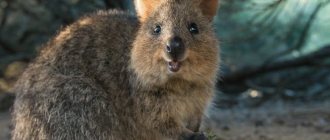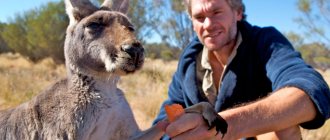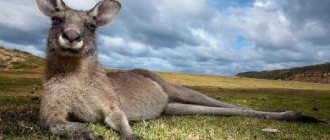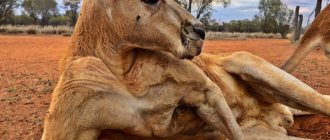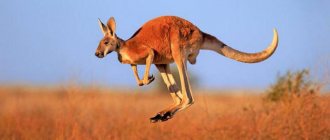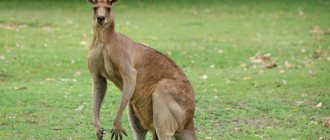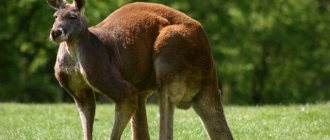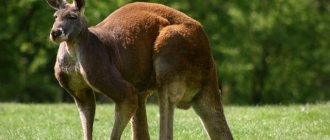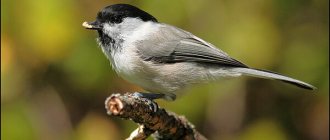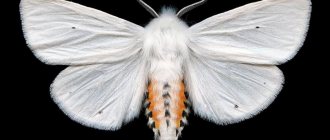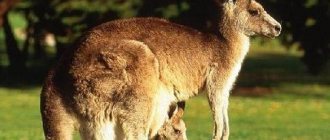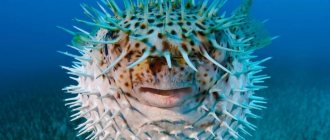The kangaroo family includes many species of animals that have a lot of differences. But the quokka has a specific feature that is unique to it - its tail is too short. This element of the body in all kangaroos is actively used as a support. Thanks to the tail, the vast majority of kangaroo species are able to defend themselves by striking the enemy with their strong hind legs. The quokka's small tail does not allow this to be done.
This small jumping animal is covered with medium-sized fur. The color is usually reddish, sometimes with gray shades. Fur covers the entire visible surface of the quokka's body, except for the tail and tips of the paws. The skin in these places is dark, almost black.
The quokka's hind legs are powerful, allowing it to jump. The front legs are much shorter and weaker. With their help, the animal picks up and holds food. Quokka feeds on grass, leaves, shoots and fruits of trees.
Appearance and features
Quokka animal
The quokka is a small animal with a fairly dense and rounded body; its hind limbs and tail are not as long as those of other kangaroos. The length of the tail is approximately 30 cm, it is covered with coarse bristles, the tail is used by animals as a balancer when jumping, but it does not have the same strength as that of ordinary kangaroos, so it is not a support. On the pretty face, plump cheeks and neat rounded ears, as well as a black nose, are immediately noticeable. The quokka has no fangs, but only 32 small teeth.
The quokka's coat is quite thick, but the fur is not long. It has a grayish-brown color with some reddishness, the belly is lighter than the main tone. The red color appears most prominently in the neck and face, and the animal’s paws have a dark, almost black tint. Some animals have a predominantly gray tone in color. With their short front legs, quokkas tear off leaves and hold fruits and plants during a meal, which looks very funny and interesting.
In general, quokkas have a very good-natured, peaceful and attractive appearance. The animals simply captivate with their cheerful faces. Tourists dream of taking a photo with this cute creature, but the quokka is not averse to it, because she is very curious and loves attention to her kangaroo person.
Character and lifestyle
It leads a predominantly nocturnal lifestyle, because during the day too many hungry predators walk around the islands, which quokkas are simply unable to resist. Dogs, foxes, cats and other predators are always happy to feast on such easy prey. In case of danger, the quokka begins to loudly bang its paws on the ground.
In normal times, quokkas prefer to maintain their own privacy and live alone, pairing up exclusively in the winter months for the purpose of mating and procreation.
Features and habitat
The quokka is not a widespread animal. It can only be found in Australia on the islands off the coast of the green continent. One of these very islands was named by the Dutch “Rottnest”, which means “Rat’s Nest”.
And this island received this name for a reason (after all, there are no traces of rats there), but precisely thanks to its cute little inhabitants - kangaroo quokkas, which in appearance are very similar to rodents.
Quokka habitat
Quokkas historically ranged throughout Australia, but their population declined rapidly during human settlement on the mainland. The reason for this is not poaching or industry, but animals brought from the continents that hunted marsupials.
Quokka habitat
Quokkas are defenseless creatures, they cannot fend for themselves in front of predators, and in its habitat there have never been any predatory animals, so quokkas are absolutely not adapted in this regard. The main enemies of quokkas at the moment are ordinary domestic cats and dogs brought by people.
Interesting fact: on Rottnest Island you must handle quokkas carefully; you should never break the rules - you will be subject to a large fine. The least fine is only for feeding human food - 300 US dollars, if you cause injury - 50 thousand US dollars, and for murder you face a real prison sentence of up to five years.
Now the animals live on small islands around Australia - in Balda, Rottnest and Penguin. Sometimes they can be found on the continent in Albany. Quokkas prefer to live in dry grassy fields where there are dense bushes.
Quokka enemies
Quokkas are completely defenseless against predators; they have neither powerful tails nor fangs and claws. They always live in large families, headed by a dominant male who controls the external environment around the family’s temporary shelters. Quokkas are kind and absolutely non-aggressive. They will not conflict with other animals that enter their territory.
Interesting: The largest seasonally dry rivers - list, names, when they dry up, description and photo
The animals are trusting, love people and make contact easily. Quokkas were listed in the Red Book in order to preserve their population. There really aren’t that many of them left – in Australia there are only 4 thousand quokkas living in families of 50 individuals. For causing harm to animals, poachers are subject to large fines and even prison sentences.
Interesting fact : the dingo dog, which appeared on the islands 3.5 thousand years ago, as well as foxes, cats and dogs brought from other continents, greatly reduced the population of animals. The only place predators did not penetrate was Rottnest, where the animal population remained unchanged until the arrival of humans, who introduced many viruses and infections.
Quokka lifestyle
Historically, the quokka, like other kangaroos, was widespread throughout almost the entire territory of Australia (list of animals of Australia). But with the beginning of active settlement of the mainland, the population began to decline sharply. Moreover, the reason for this was not banal poaching or industrial development, but imported animals.
Quokka is a defenseless creature. She does not know how to fight like a large kangaroo, and is not adapted to meeting predators. Moreover! There have never been large predatory animals in its habitat. Therefore, the main enemies and destroyers of quokkas were ordinary cats and dogs that people brought with them.
Today, this small animal lives on the islands of Bald, Rottnest and Penguin, located near Australia. Also found on the continental part in the area of the city of Albany. The typical habitat of quokkas is dry grassy fields with dense bushes.
When living conditions become uncomfortable, quokkas are able to undertake migrations and move to atypical places. So, during severe drought, they move en masse to swampy areas, where they find an acceptable amount of water and air humidity.
Quokka is a nocturnal animal. She has fairly good eyesight, a keen sense of smell and hearing. During the daytime, the animals show little activity, often hiding in the bushes.
The quokka has a very interesting feature in the area of reproduction. After mating, the female produces not one, but two embryos at once. Moreover, one of them begins to develop, and the second goes into a pause phase.
Like all members of the kangaroo family, the quokka has a pouch for carrying its offspring. She gives birth to one calf and nurses it in her pouch for a long time. At this time, the second embryo begins to develop and is born after its “big brother” leaves the mother’s pouch. Thus, the female goes through the stages of two pregnancies after just one meeting with the male.
Where does the quokka live?
In the wild, the animal's habitat is limited to a very small area in southwestern Australia. Populations are small and fragmented. The largest and most stable population lives on Rottnest Island, with slightly smaller animals living on Bald Island. The islands are free from predators, there are no foxes or wild dogs, so the animals feel safe. On Rottnest, short-tailed kangaroos are found throughout the island, from cultivated gardens to arid bushland.
What does a quokka eat?
Kangaroo quokka
The menu of these little kangaroos is exclusively plant-based. Quokka can be confidently called one hundred percent true vegetarian. Nature did not endow them with fangs, and the animals’ small, strong teeth are capable of coping with a variety of vegetation.
The diet of these unusual marsupials consists of:
- various herbs;
- foliage;
- young shoots;
- fruit;
- berries
It’s not for nothing that quokkas inhabit grassy areas, densely overgrown with bushes; they often build something like tunnels from grasses for shelter and safer feeding. Since animals are active at night, they go in search of food at dusk. Basically, the animals look for tasty things on the ground, in thickets of grass, but, having noticed a young and juicy shoot, they can also climb a tree to a height of about one and a half meters.
Small, kangaroo-like, front paws are akin to human hands; with them, marsupials tear off leaves that they like, funnyly hold fruits and shoots, bringing them to their mouths during snacks. In photographs popular on the Internet, a quokka can often be seen with something tasty in its tenacious front legs.
It has been noticed that animals practically do not chew food, but bite off and immediately swallow. They often regurgitate the undigested remains and may eat the gum again. The quokka is quite hardy and although it constantly needs water, it can do without it for quite a long time, receiving moisture from succulent vegetation.
Quokka nutrition
These babies of the kangaroo world are exclusively herbivores. For this reason, they choose places rich in vegetation for their settlement, mainly marshy areas. Also, thanks to the powerful hind legs, like all kangaroos, quokkas easily climb trees to a height of up to one and a half meters in order to prey on young shoots.
Quokka - description
Quokka is the only representative of its genus in the kangaroo family, so it looks like a fat kangaroo. The size of the animal is small - most often they do not grow larger than cats. The height of an adult is 47-50 cm, and the weight is up to 5 kg.
The large family of kangaroos includes many species of animals that are radically different from each other. Quokkas have a very short tail - 35 cm, used as a support. Kangaroos have a tail for a reason - it is an opportunity to protect themselves from predatory animals, but quokkas are not able to do this.
quokka
The small jumping animal is completely covered with thick medium fur of a red or grayish-red color.
Without hair, only the tail and tips of the legs remain on the quokka's body - in these areas the skin is dark, almost black. Powerful hind legs enable the animal to move by jumping at speeds of up to 50 km/h. The front legs are small and weak, they are needed so that the animal can eat. The quokka lifts and holds food with them. The animal's diet includes grass, plant shoots, fruits and leaves. Interesting fact : quokkas are very curious animals, they are interested in communicating with people.
However, despite their friendly appearance, they are not always worth petting. Quokkas can accidentally jam their jaws into your hand, and they bite small children every year. Animals, of course, will not cause irreparable harm, but children will be scared, and bruises will remain on the skin. Quokkas are born without hair, gradually acquiring thick gray-brown fur. The ears are round, located close to each other. Thanks to them, the animal’s appearance is slightly comical and cute. Together with a constant smile, a feeling of good nature is created. Small button eyes are located near the bridge of the nose. The animal has no fangs; leaves and stems are bitten off due to the impact of powerful jaws. They live in large families of up to 50 individuals.
Baby quokka
Quokka and man
Scientists have assigned the quokka status as a “vulnerable species.” This means that without taking measures for registration and conservation, the number of animals may begin to decline critically. Considering that it takes root well in artificial conditions, people often keep quokkas at home. In various zoos and tourist attractions, you can touch and even feed quokkas. The amazingly touching face of this animal rarely leaves tourists indifferent, and its amazing photogenicity surprises and most often leads to entire photo sessions.
Origin and appearance
This adorable little creature belongs to the kangaroo family. One of the distinctive features of the quokka is its very short tail (the second name for this animal is the short-tailed kangaroo), which is extremely atypical for a kangaroo. With the help of its tail, the kangaroo defends itself and also strikes in a fight. Quokka does not have such advantages.
These little jumpers have medium-length reddish fur. Their hind legs are powerful enough to allow them to jump actively and quickly. They hold food with the help of their forelimbs.
Where do they live and what do they eat?
Quokkas were once abundant in Australia. Unfortunately, when the mainland began to be actively populated, their number began to decrease noticeably. This was due to the activities of poachers and animals brought by people. Quokkas are quite difficult to survive in the wild due to their vulnerability. They are not created for fights and can do little to resist not only predators, but even dogs or cats.
Now these babies can be found on islands near Australia, for example, on Rottnest or Bold Island. They usually live in fields covered with dry bushes. It is vital for them to have a source of fresh water nearby. If a severe drought occurs, they can move to swamps, where there is always a lot of moisture. In addition, there are no predators in swampy areas, and therefore the quokka can feel safe. Quokkas are nocturnal. During the day they are not so easy to spot in the wild. When it is light, they sleep or hide in the bushes.
Quokkas are herbivores and feed mainly on grass, shoots and leaves. Mostly they find all their food on the ground, but if necessary they are able to climb a not very tall tree.
Reproduction
Like all kangaroos, quokkas carry and raise their young in a pouch. While the female is bearing the cubs, the male tries with all his might to protect her from enemies. After six months, the baby can already leave his mother’s bag and explore the world on his own.
Quokkas have an interesting feature related to reproduction. If the baby dies during gestation, the mother begins to develop a second embryo. There is no need to re-pair. The fact is that the second embryo is already inside the mother. If the first child survives, the second will begin to develop when the first leaves the pouch.
How does man influence these animals?
Quokkas are going through a difficult time right now and need protection. If you do not begin to take the necessary measures to preserve their population, over time they may disappear altogether. Fortunately, quokkas adapt well to life in zoos and nature reserves, where they live much calmer than in the wild.
Seeing a quokka for the first time, few people remain indifferent. Tourists never miss the opportunity to take pictures with these smiling animals. But don't relax too much around a quokka. There may well be malicious intent behind a smile, so you should feed them carefully. They have rather sharp claws on their paws and can easily scratch a person if they sense danger.
Description and origin of the species
Europeans first discovered the animal in 1658, when the Dutch navigator Samuel Volckertzoon wrote about a “wild cat” he encountered on Rottnest Island. In 1696, another Dutch traveler, Willem de Vlaminck, mistook the animals for huge rats, and named the island inhabited by them Rattenest, which translated means “nest of rats.” This is how Rottnest Island got its name.
The word "quokka" comes from the Aboriginal language of Western Australia. It originally sounded like gwaga.
Interesting facts about quokka
They need very little water
To survive, these cuties need very little water. Although these animals prefer to live near bodies of water, they rarely drink. This is because they can extract most of the water they need from the plants they eat - their favorite plant is guichenotia (flowering bush). When water supplies are low and food supplies remain stable, quokkas can go without water for a month.
Quokkas eat their food twice
Quokkas survive on leaves and grass, but they don't actually chew their food—they simply tear up the vegetation, stuff it into their mouths, and swallow it. This is not the best way to break down food and not the most efficient way to extract nutrients from it. But quokkas have a unique solution - they regurgitate their food and eat it again. Because the cud they regurgitate is much more processed, their digestive systems can better extract vital nutrients from it the second time around.
Quokkas produce no more than two offspring per year
Quokkas on the mainland mate frequently, but females rarely give birth to more than one baby per year. At most, they will have two of them. Those on Rottnest only breed from January to March when the weather gets cooler. Pregnancy lasts only one month, after which the babies enter their mother's pouches for protection, warmth and nursing. Babies remain with their mothers for several months before they begin to live independently. After a year they are ready to mate.
Reproduction and lifespan
Despite living in families, quokkas love privacy. Communication between males and females occurs only during the mating season. The rest of the time everyone is on their own. Control over the family is exercised by the dominant male, who protects the shelters from incursions by other animals.
The dominant male is the father of most of the cubs of the family. The rest of the males get everyone who remains. There are no battles for power among animals; when the leader gets old, he transfers his powers to the strongest.
A female can become pregnant in the first 28 days immediately after mating begins; after the same period, the first baby is born, which matures for five months in the mother’s pouch; after it matures, the second is born. It waits another 28 days to be born after the first one is released, and then goes into the mother’s pouch.
If there is little food, then the second baby may not be born at all. Quokkas live a short lifespan - up to 10 years, so sexual maturity occurs quickly - females do not even have a year of life.
Childbearing
Female short-tailed kangaroos are capable of producing one offspring per season. The continent is characterized by breeding twice a year due to the risk of losing offspring.
Pregnancy lasts one month. Immediately after birth, the baby is moved to the mother's pouch, where it remains for six months and continues to develop physically.
Quokka with baby
It is worth noting that immediately after giving birth, the quokka mother mates again and activates “embryonic diapause” - this is a protective mechanism for childbirth. The embryo remains in a state of diapause for about 5 months. Photo of a quokka with a baby below.
Another embryo is needed to restore offspring in the event of the loss of the first baby. If everything is fine with the quokka baby, then the embryo disintegrates. If the baby dies, the embryo is implanted and begins to develop in the womb of the quokka mother.
Little quokka
After being separated from the pouch, the cub begins to explore the world around it. By nine to twelve months, the young quokka reaches sexual maturity. From this moment on, the baby can be considered an adult.
Social structure and reproduction
Photo: Baby quokka
Quokkas become sexually mature when they are one year old or a little earlier. Their wedding season occurs at a time when it is cool outside, namely, it begins in January and lasts until March. Most often, marsupial females themselves begin to choose a partner. The rejected gentleman retreats and begins to court another lady. If the potential groom is to her liking, then the female shows this in every possible way, hinting that she is ready to mate. Large males always act as dominants and are chosen much more often. They often enter into fights for females with gentlemen of lower rank.
After intercourse has occurred, the male becomes the protector of his chosen one. A couple can survive for two mating seasons. Quokkas are polygamous, so each partner has other hobbies on the side. Females can have about three more suitors, and males can have up to five partners.
Interesting fact: As for social structure, it differs between males and females. Females have virtually no contact with each other, but males can communicate with other females, observing a kind of hierarchy based primarily on the size of the animal.
The duration of pregnancy is approximately a month, after which only one tiny cub is born, it is blind, deaf and devoid of fur. The baby remains in her mother’s pouch for another six months, where she continues to develop and be fed with mother’s milk. When he is six months old, he gets out and tries to integrate into the world around him, but he does not go far from his mother, constantly being fed with milk. This continues for several more months until the baby gains final independence.
It is worth noting that nature took care of quokkas, providing for such a characteristic phenomenon as embryonic diapause. In other words, the female has another spare embryo, which is stored in her body in case the born baby dies. If such a misfortune befalls a quokka mother, she gives birth to a second baby, without requiring the fertilization of a male. This is how the kangaroo’s life is interesting, which in natural conditions lasts for ten years, and in captivity a quokka can live up to 14.
Quokka name and discovery
Quokka collects leaves in autumn
Short-tailed kangaroos received the name quokka thanks to the indigenous Australian tribes. They called Setonix brachyurus "gwagga" and "kwaka". Visiting colonists adapted the name to suit their own dialect.
Let's look at the Latin name. Setonix is the name of the genus, and brachyurus is translated from Latin as “short tail.”
Before the official discovery of the species, short-tailed kangaroos were accidentally discovered more than once by European colonists. For example, in 1660, a sailor named Samuel Wolkertzoon discovered and described quokkas as wild cats.
Decades later, Dutch traveler and explorer Willem de Vlaminck arrived on the modern island of Rottest and came across Setonix brachyurus. The Dutchman described the animals as giant rats. By the way, it was Willem de Vlaminck who gave the name to the island in honor of the famous Dutch phrase - rat's nest.
Kinds
A unique animal, the only representative of its kind. The closest relative is the wallaby, otherwise called the dwarf kangaroo; they are in an intermediate stage of development between ruminants and non-ruminants.
Wallaby
Rottnest Island, which is located 18 km from the western coast of Australia, is named so precisely because of these cute animals. Dutch sailors who discovered the island in the 18th century found hordes of amazing smiling animals there, a bit like rats because of their tails. The name Rottnest, which stuck in those years, is otherwise translated as “rat’s nest.”
Interesting: Why does the boomerang come back? Explanation, drawings, photos and videos
Smiling quokka animal in the Red Book
Quokka in the forest
The International Union for Conservation of Nature has listed short-tailed kangaroos as endangered. The quokka is listed as “vulnerable to extinction in the environment.” Therefore, keeping a quokka at home is punishable as a criminal offense.
The IUCN estimates there are between 7,500 and 15,000 adult short-tailed kangaroos worldwide.
To make a quokka smile, you need to feed it
It’s just like with people: we become kinder after a cake or a portion of fried potatoes. The quokkas, having eaten, also begin to smile. Their physiology is this: the quokka’s chewing muscles relax after eating, and they get a charming smile, for which the quokka is loved by everyone who has a heart and an Instagram account. It was from this social network that a couple of years ago the hashtag #quokkaselfie spread, which made quokkas so popular for photos.
Publication from Kat, 22. ?Australia. ????? (@katwright4) Mar 2 2017 at 2:28 PST
Population and protection of the species
Before European colonization of Australia, the quokka population was much larger. The habitat of the animal at that time extended over approximately 41,200 square kilometers, including 2 islands, Bold and Rottnest. At the end of the 20th century, the number of animals decreased noticeably, and their habitat decreased by more than 2 times, to 17,800 square kilometers.
Although quokkas are common on the islands, the animal's population on the mainland is under constant pressure. Therefore, the quokka is included in the International Red Book with the status of a species in a vulnerable position.
The following factors have a negative impact on the number of short-tailed kangaroos on the mainland:
Although quokkas actively reproduce (females mate the very next day after giving birth), the small size of the litter, the abundance of predators and the reduction of their natural habitat have so far severely limited the population of animals on the mainland.
The number of animals on the continent is estimated by experts at approximately 4,000 individuals. There used to be even more of them, but in 2015 a huge bush fire in Northcliffe destroyed 90% of the local population of 500 animals. From 8,000 to 12,000 animals live on Rottnest Island, and from 600 to 1,000 animals on Bald Island. In late summer and early autumn, during the dry season, animal numbers on Rottnest Island traditionally decline due to a lack of water and edible vegetation.
Interesting Facts
- In 2015, tragedy struck: in the city of Northcliffe, located on the west coast of Australia, there was a fire that destroyed 90% of the quokka population (500 individuals).
- In August-September on Rottnest Island the groundwater level decreases and a period of drought begins. Under these conditions, the reserve's staff takes special measures to preserve the quokka's habitat.
- Quokkas are curious, not afraid of people and freely approach them on Rottnest Island. Despite their friendly appearance, petting them is not recommended. Every year, cases of quokka bites of people, especially small children, are recorded. The animal cannot cause serious harm, but it is quite possible to scare and leave a bruise on the skin.
- The quokka on Rottnest Island must be handled with care, and any violation of the rules of communication will result in a fine. The smallest is the fine for feeding human food. So, for handing a cookie or candy to an animal, you are entitled to $300, for causing injury - up to $50,000, for murder - 5 years in an Australian prison.
- Settonix can be seen in the zoos of Petra, Adelaide, and Sydney, but it was noticed that in open enclosures the animal hides from human eyes. For this reason, the animals are kept behind glass with a strict ban on any contact by zoo visitors.
- Enormous damage to the quokka population was caused by the dingo dog, which appeared on the island 3,500 years ago, and the red fox brought by Europeans in 1870. The only place where these predators did not penetrate was Rottnest Island. Today, the main enemy of quokkas on the island is humans, in particular, infections and viruses brought by them.
Quokka at home
Looking at the funny photos of the animal, many want to have an animal at home, but for now this is not possible. The animal cannot be bought in Russia. This is not surprising: the quokka is a unique endemic species, found only in a small part of Australia, and is under government protection.
According to Australian law, the animal cannot be kept as a pet within the country, and cannot be taken outside the country. Therefore, the only way to see a live quokka is to go to Rottnest Island, or visit one of the zoos where the animals are kept - in Perth, Sydney or Adelaide.
Care and maintenance at home
The quokka is so charming that it gives the impression of a cute and calm animal that you want to see at home, play with and pet. But this is primarily a wild animal, not adapted to life with people.
Theoretically, it is possible to recreate the conditions of the habitat, but it is impossible to adapt the domestic quokka to the human lifestyle. Among the most common problems in adapting settonix to home conditions are:
1. The animal lives only in hot tropical or subequatorial climates. He is thermophilic, despite his love for darkening. At the same time, the quokka cannot live in an apartment; it needs greenery, tall grass and fresh green shoots. The animal loves to build green corridors from tall grass and builds huts where it hides from the sun's rays.
In an unnatural environment, the animal will experience discomfort and often get sick. In the garden, you can recreate savannah conditions with the help of shrubs and low-growing trees, but this requires a large space and constant professional garden care;
2. Quokka is listed in the Red Book, so export from Australia is prohibited. You can purchase an animal illegally, but in temperate latitudes, life expectancy will be reduced by 2 times. Paying a lot of money for the animal itself and its maintenance is a huge risk.
An animal can live a maximum of 7 years, and this is in a reserve where its natural habitat is preserved. In a good zoo, Settonix lives 5-6 years. At home, even the best, life expectancy is reduced to 2-4 years;
3. Quokka is not compatible with cats and dogs. Communication between animals ends in injuries and constant stress for the Australian inhabitant. Dogs react aggressively to exotic animals; cats also do not like such a neighborhood;
4. Settonix is nocturnal. During the day he sleeps, and people want to play with this charming creature. Disruption of sleep and wakefulness is fraught with decreased immunity. Few people will like moving around the apartment at night. As with other wild animals, ferrets, raccoons, chinchillas, problems will arise with a quokka in a city apartment or private house.
Driven by natural instinct, the animals will build shelters from what is nearby - newspapers, furniture, clothes, shoes. Leaving him alone for several hours, the owner may be shocked by the “redevelopment” of the apartment to suit the taste of the quokka;
5. We must remember that these animals live in families. And that a female needs a male, and a male needs a female, at least once a year. If this is not done, the quokka will suffer a hormonal imbalance. The natural balance is disrupted, which can lead to illness and death of the poor animal;
6. Don’t forget that this is a kangaroo that moves in a very specific way. He needs to jump, and for this he needs space. It is difficult to jump high in an apartment;
7. The stomach of a quokka contains 15 types of bacteria responsible for digestion. And not one of them is adapted to digest the food that humans eat. Even accidentally eaten cookies cause diarrhea and dehydration;
8. Settonix has a need to maintain water balance. Despite the fact that the animal drinks little, the main source of fluid in the body is plant foods. The animals consume plants that grow in areas with an annual precipitation of at least 600 mm. Many people want to see the quokka smile every day, but it is worth remembering that we are responsible for those we have tamed.
Price
In Russia and the CIS countries, the price of a quokka varies from 250,000 to 500,000 rubles. However, it is almost impossible to find an animal for free sale.
Best animal for selfies
Tourists and residents of Australia cannot ignore this fluffy and glorious marsupial. Many who come across a quokka in their life immediately lose their minds and rush to take a “quash” selfie with it.
Moreover, social media users even started the hashtag #quokkaselfie. The incredible popularity of the quokka has led to the fact that special tours are even organized to the islands to take a selfie or photo with its participation.
Of course, there are other animals in Australia that you can take photos with. For example, with a kangaroo, which can knock you down with one blow. However, people believe that taking photos together with a friendly quokka is much more enjoyable and safer. At least so far, no cases of human death from the paws of a cheerful and harmless animal have been reported.
These furry babies easily make contact with people and, judging by their happy faces, they really enjoy being photographed! These smiling animals have become more popular even than koalas! It is quite possible that soon, thanks to its unusual face, the quokka will become an unofficial symbol of Australia. And this is not surprising. After all, the quokka is one of the most charming animals in Australia.
Colady's editors can't help but smile when looking at this cute little animal. Quokka will melt any, even the coldest heart. Surely you will also want a bright and memorable photo with the most smiling animal in the world.
Attention! While watching, a feeling of tenderness may appear repeatedly.
Why does the quokka smile all the time?
Quokkas are famous for their far from funny lifestyle and good nature; small mammals, listed in the Red Book, constantly smile. This signature smile has made the animals famous all over the world. It seems that the animal constantly admires everything that happens around, without losing optimism. Millions of tourists come to Australia every year to buy or take pictures with a quokka.
The smile of an animal is nothing more than the result of relaxation of the jaw muscles after chewing food for a long time. Animals feed on hard eucalyptus leaves, chewing them like cud. You cannot feed animals with your own food, as this can result in a heavy fine.
Nutrition
Diet of quokkas
Quokkas live in hard-leaved forests, feeding on young shoots of eucalyptus, a variety of flowers, many roots, seeds and grass. All these plants have hard fibers, which the quokka gradually grinds with its jaws, this is a long process. Quokkas make funny sounds. The food is swallowed, spat out, and chewed like chewing gum. At the end of the meal, the animal relaxes its jaw muscles and smiles radiantly at everyone.
The animals obtain food at night, moving among the grass. Quokkas can climb to a height of up to 1.5 meters, collecting young shoots of trees. The gastrointestinal tract bacteria of quokkas resemble those of sheep. During drought, animals migrate to other lands for food and water. If the drought does not last so long, then the animal can get water from succulents with juicy pulp. The quokka's closest relatives, the wallaby, are much less adapted to high temperatures; quokkas can thrive in temperatures up to 44 degrees Celsius.
Interesting: Why is Greenland an island?
